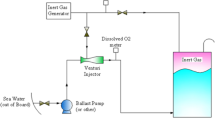Abstract
The ballast water of oceanic ships is the main cause for worldwide transfer of non-indigenous aquatic species. The use of hydroxyl radicals is an efficient method for killing the aquatic species in ballast water. For practical application, a 250 t/h ·OH ballast water-treatment system was designed and installed on the ship Yulong (ten thousand tons) in Dalian harbor. On this ship, a series of experiments were carried out. As a result, the concentration of total oxidants declined over time. Harmful aquatic organisms and pathogens in the ballast water were rapidly killed after ·OH treatment and no re-growth was observed during a storage time of 5 days. The quality of the ballast water was considerably improved. Therefore, the D-2 ballast water discharge standard of the International Maritime Organization was satisfied. Compared with current methods, ·OH treatment is a potentially effective technology which can be practically applied in the ballast water-treatment of oceanic ships in the future.





Similar content being viewed by others
References
Ruiz GM, Fofonoff PW, Carlton JT, Wonham MJ, Hines AH (2000) Ann Rev Ecol Syst 31:481–531
Niimi AJ (2004) Marine Pollut Bull 49:778–782
Carlton JT (1994) In: Proceedings of conference workshop on NOAA pp 5–11
Bai MD, Bai XY, Zhang ZT, Yang B (2005) Plasm Chem Plasm Proc 25(5):530–538
Gollasch S, David M, Voigt M, Dragsund E, Hewitt C, Fukuyo Y (2007) Harmful Algae 6:585–600
Matousek RC, Hill DW, Herwig RP, Cordell JR, Nielsen BC, Ferm NC (2006) J Ship Prod 22:160–171
Kim EC, Lee KP (2009) Oceans-Europe 1–2:1308–1315
Wright DA, Dawson R, Orano-Dawson CE, Moesel SM (2007) Marine Technol 44:57–67
Herwig RP, Cordell JR, Perrins JC, Dinnel PA, Gensemer RW, Stubblefield WA (2006) Marine Ecol Prog Ser 324:33–55
Liu GZ, Wang JM, Zhang JQ, Cao CA (2010) Acta Metall Sin 46(9):1093–1097
Tsolaki E, Diamadopoulos E (2010) J Chem Technol Biotechnol 85:19–32
Boldor D, Balasubramanian S, Purohit S, Rusch KA (2008) Environ Sic Technol 42:4121–4127
California Environmental Protection Agency (CEPA), State Water Resources Control Board (2002) Evaluation of ballast water treatment technology for control of nonindigenous aquatic organisms; technical report. http://www.calepa.ca.gov/publications/Reports/Mandated/2002/BallastWater.pdf
Mamlook R, Badran O, Abu-Khader MM, Holdo A, Dales J (2008) Clean Technol Environ Policy 10:397–407
Bai XY, Zhang ZT, Bai MD, Yang B (2005) Plasm Chem Plasm Proc 25(1):41–54
Bai MD, Zhang ZT, Xue XH, Yang XL, Hua LS, Fan D (2010) Plasm Chem Plasm Proc 30:831–840
Zhang ZT, Xian YZ, Bai MD (2003) Physics (in Chinese) 32(7):458–462
Westerhoff P, Amy G, Song R, Minear R (1998) Water Res 32:1687–1699
Von Gunten U, Hoigné J (1996) CRC, Boca Raton, pp 187–204
Lei H, Marinas BJ, Minear RA (2004) Environ Sci Technol 38:2111–2119
Hofman R, Andrews RC (2001) Water Res 35:599–604
Acknowledgments
The work was supported by Projects of Distinguished Young and General Program from National Natural Science Foundation of China (NSFC: 61025001; 50877005), “Cheung Kong Scholars” Program and National 863 Program (No. 2012AA062609) from Education Ministry of China.
Author information
Authors and Affiliations
Corresponding author
Rights and permissions
About this article
Cite this article
Bai, M., Zhang, Z., Zhang, N. et al. Treatment of 250 t/h Ballast Water in Oceanic Ships Using ·OH Radicals Based on Strong Electric-Field Discharge. Plasma Chem Plasma Process 32, 693–702 (2012). https://doi.org/10.1007/s11090-012-9369-9
Received:
Accepted:
Published:
Issue Date:
DOI: https://doi.org/10.1007/s11090-012-9369-9




